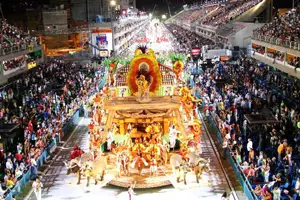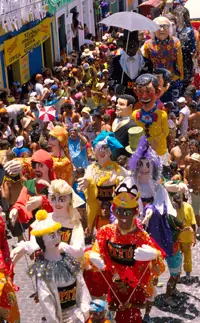
Around the globe Carnival is celebrated with costumes, colorful parades, don’t-stop-til-you-drop music and dancing in annual extravaganzas. As the exuberant, joyous revelry takes fuel, each country satisfies hunger and thirst in distinctive ways. Feasting is an integral part of the merriment and certain dishes are made for the occasion.
Competing samba schools parade through Sao Paulo, Brazil, each vying for the title of best school (see photo).
Carnival made its first appearance in 13th century Venice, as a Catholic adaptation of a pagan festival with lavish costumes and balls. As a time to indulge in rich foods and entertainment before the 40 days of Lenten fasting and prayer, the pleasurable tradition spread easily to other Catholic countries. French and Spanish colonists brought Carnival to the New World where it was imitated and adopted by African slaves and other settlers. Food is still an integral part of the celebration with a medley of ingredients and cooking styles.
Brazil
The first ever Carnival in Brazil is said to have taken place in Rio de Janeiro in 1641, when John 
Samba, which originated in Bahia based on African rhythms, has become the national music of Brazil. Dancers from Samba schools practice to compete during the parades held most notably in Sao Paulo and Rio de Janiero. Papier-mi¢che puppets (see photo), massive floats, and trucks on which singers and bands perform are additional parts of the parade/street party bacchanal.

Street food venders sell pastries and bolos (muffins / pies) with many different fillings (from fruits to fish and beef, served salty, sweet or extra-spicy). Typical Brazilian dishes such as acaraje (black eyed pea fritters filled with shrimp and onions), and pao de queijo (cheese rolls made with tapioca flour) are offered in the streets of Brazil during carnival season. Festival-goers will also find a variety of meat such as sausage, grilled meat, and meat on skewers.
Partiers may also relish the country’s most famous dish, feijoada, a hearty stew of beans, beef and pork. Since it is a heavy dish, it is usually eaten after the parades or at a time when people know they can rest after eating it.
Tip from Embratur: Tickets for Carnival events in cities other than Rio are less expensive but offer an equally colorful and spirited experience.
Trinidad and Tobago
Almost all of the Caribbean islands celebrate Carnival and one of the most popular is held on Trinidad and Tobago. The extravagant fiªte, beginning right after Christmas and lasting to the Tuesday preceding Ash Wednesday, includes steel pan (steel drum) and calypso competitions, along with parades and dancing.
Islanders spend months designing ornate costumes and elaborate floats. Trinidad native Amrod Phillips adds, “Members of the community come together and strive to make the prettiest floats. Some have been making floats for years but there are also first timers who join the fun. Most floats are pulled. Big trucks get decorated and carry steel pan bands,” Phillips says.
“The towns in Trinidad have their own carnivals that eventually come together in Port of Spain. The finalists of the steel pan competitions also end up in the Port of Spain and the crowds follow for one massive celebration.”
Masquerading and dancing down the road all day burns calories. Eating and socializing, as elsewhere, are a major part of Carnival and the food is a mixture of the cultures that settled on the island. Indian indentured workers brought in after slavery was abolished added chutneys, curries and flatbreads. Roti, doubles, pigeon peas and rice, and fried chicken make the menu during Carnival according to Phillip. Roti, East Indian in origin, are wraps filled with goat curry, pork, chicken curry, shrimp or vegetables. Doubles, the most popular street food during carnival, are sandwiches filled with chickpeas topped with spicy chutneys. People also like, “Candies made with coconut and sesame seeds.” Another favorite at Carnival is pigfoot souse, or pickled pig feet.
For beverages, “Carib lager is very popular. It is the hallmark lager of Trinidad. If you are cool or want to be, you have a Carib in your hand! Mauby (made from the bark of a tree) is Trinidad’s version of Kool-aid.” Know before you go!
Phillip and other SoCal Trinidadians get their street food fix at Caribbean Treehouse Restaurant in Inglewood where roti, doubles, curried goat, chicken and shrimp are served.
Tip: Carnival events on Trinidad and Tobago are free to onlookers and participants alike.
New Orleans
“While most parts of the country spend January, February, and March recovering from the decadence of the holidays, New Orleanians are still eating, celebrating, and living life to the max. Mardi Gras given the name which translates as Fat Tuesday, the people of New Orleans take that seriously. So it’s ALL about consuming the best of food and drink that are emblematic of the city. You really feel you’ve not got a care in the world when you are taking part in the celebration,” says Bruno Duarte, special events manager for Ralph Brennan’s Jazz Kitchen about the country’s largest and most extravagant street party.
“Parades are the most well known activity of Mardi Gras. Starting with Krewe Du Vieux, which this year rolls on January 19th, parades will happen straight through until Mardi Gras day (Feb. 12, 2012). These parades are typically made up of 20+ beautiful and elaborate floats. The streets along the parade route shut down and thousands of people will line up on either side of the roads to catch beads and other throws.” Krewe associations organize parades and balls. The oldest, Comus, dates back to 1857. Zulu, one of the largest krewes, draws crowds to its parade to catch a Zulu coconut, an actual coconut painted gold or black.
Ralph Brennan’s Jazz Kitchen in Downtown Disney is another place to get a taste of the
In addition, “Kenny Sara and the Sounds of New Orleans will be on stage playing Mardi Gras favorites. Get your beads and napkins ready to start a parade when they start playing Saints Go Marching In’,” says Duarte (photo right).
Laissez les bons temps rouler!
